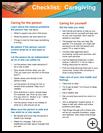
Caregiver's Guide: Brief Version
________________________________________________________________________
KEY POINTS
- As a caregiver, you take care of someone who is sick or disabled. Caregiving can be very hard work.
- Learn about the medical problem the person has. Try to make sure the person is safe and has what he or she needs.
- It's okay to say that you need a break or need help. Tell people how they can help. Check with state agencies or churches about what services they offer.
- Take care of your own health and feelings. This helps you and the person you take care of.
________________________________________________________________________
As a caregiver, you are taking care of a relative or friend who is sick or has physical or mental health problems. Caregiving can be very hard work. There are often a lot of needs to be met and decisions to be made. There may be times when it seems like too much for you. It's okay to say that you need a break or need help. Here are some ideas to help you and the person you care for.
Caring for the person
Learn about the medical problem the person has. Ask about:
- What to expect now and in the future
- What the person can and cannot do
- Things to look for that mean something is wrong
Be patient if the person cannot control what he or she says or does. This may be especially true for people who have dementia, a head injury, or stroke.
Let the person be as independent as he or she can safely be.
- Let the person help make decisions if he or she is able.
- Give simple choices when you can. ("Do you want your red shirt or the blue one?")
- Let the person do things for him or herself when possible. For example, you could seat the person in front of the sink, set out the toothbrush and toothpaste, and help only if needed.
- Give directions in short, simple steps. For example, say "Pick up your coat, put your arms in, button it up," rather than "Put on your coat."
- Tell the person what to do instead of what he or she should not do.
Make sure the person is safe and has what he or she needs.
- Be flexible and know that the person’s needs may change.
- Watch for changes. Talk to the healthcare provider about changes that you see.
Caring for yourself
You may be on duty 24 hours every day. You may have little or no time to take care of yourself. This can lead to burnout. When you take care of yourself, it helps you and your loved one. You can't do everything yourself.
Get the help you need.
- Ask friends and family to help so you can take time for yourself and take care of your own business. Don't wait for people to volunteer.
- Tell people how they can help. Be specific. For example, you might ask someone to sit with the person and watch TV or read to them.
- Contact state agencies about counseling, social work services, and home care services.
- Call the National Eldercare Locator hotline (1-800-677-1116) for help in finding resources for seniors.
- Find out what services there are in your community. Check with churches or local nursing facilities.
Take care of your own health and feelings.
- Take time to relax. Try to get at least 7 to 9 hours of sleep each night. Eat a healthy diet. Get out and have some fun once in a while.
- Join a caregivers' support group. It helps to talk with others and share problems and ideas. You are not alone.
- Talk things through with a friend who will let you express frustration, anger, and tears.
In time, the care that is needed may be more than you can do. The person may be too heavy for you to lift, or may be violent. You may have health problems yourself. Moving the person to a nursing facility may be the best thing you can do.
The caregiver's role takes a lot of time and energy. But there can be great joy in knowing that you did all you could. The key is keeping a balance between caring for them and caring for yourself.

